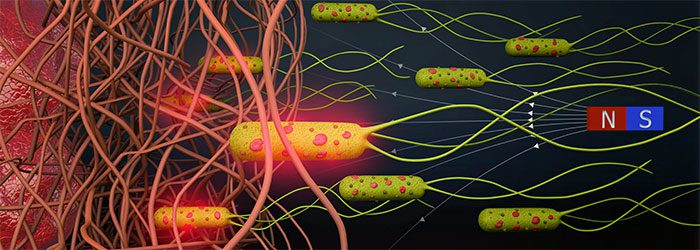German scientists have developed a type of micro-robot that is magnetically controlled, designed to surround tumors and release a large amount of chemotherapy drugs for cancer treatment. This tiny drug delivery “machine” does not affect healthy tissues and is considered a significant breakthrough in the field of oncology.

Simulation of microrobots surrounding a tumor.
For decades, scientists have utilized magnetic fields to navigate medical devices within the human body, including catheters and endoscopic cameras. Meanwhile, the bacterium E. coli is often referred to as a “superhero” of the microbial world due to its ability to swim quickly and flexibly, enabling it to traverse liquids or high-viscosity tissues. It also has excellent environmental sensitivity.
To harness these advantages, a research team at the Max Planck Institute has leveraged the power of non-pathogenic intestinal E. coli bacteria, equipping them with artificial components, including magnetic particles and spherical drug carriers known as liposomes. These bacteria-based microrobots are injected into the bodies of cancer patients. “With a magnet, we can accurately navigate them towards the tumor. Once we have enough microrobots surrounding the tumor, we use a laser to activate the release of the drugs. At this point, not only is the immune system awakened, but the additional drugs also help to destroy the tumor,” explained the lead researcher, Birgul Akolpoglu.
In trials, scientists successfully navigated the microrobots through various stages to shrink tumors in the laboratory. They assert that bacteria-based medical microrobots could one day fight cancer more effectively. This is a new therapy, but it is not too far removed from current cancer treatments.
“Eliminating the tumor in this localized manner will be less invasive for patients, reducing pain and side effects, while the treatment drugs can act where needed without affecting the entire body,” evaluated co-author Dr. Yunus Alapan, highlighting the advantages of biological microrobots over current cancer therapies.



















































